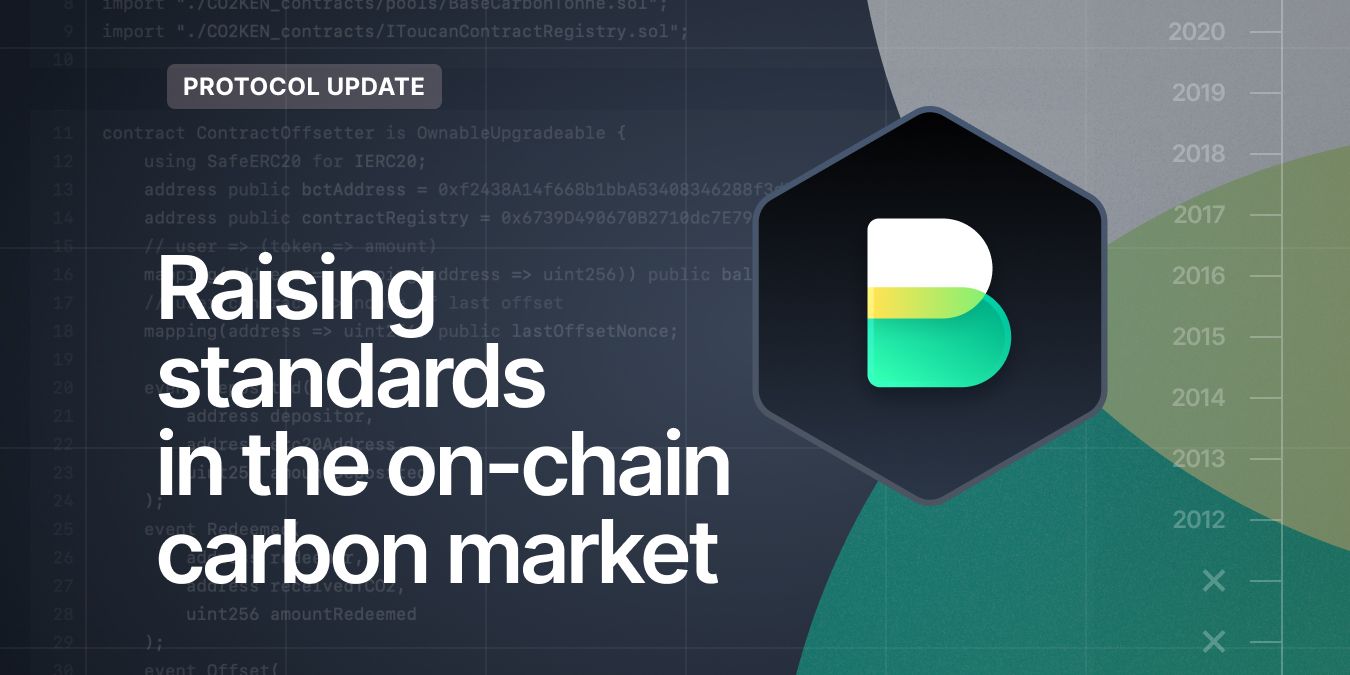Raising standards in the on-chain carbon market
Toucan is adding additional safeguards to improve the integrity of on-chain credits.

Toucan is adding additional safeguards to improve the integrity of on-chain credits. A new rule comes into effect as of today, where credits must have been issued within 10 years of their climate-positive impacts taking place.
Background
The Base Carbon Tonne (BCT) pool was developed in consultation with KlimaDAO for the launch of their protocol in October 2021. When the rules governing what credits were allowed into the BCT pool, known as the “gating criteria”, were designed, the aim was to optimise the pool for deep liquidity and fungibility. As such, the barriers to entry were deliberately low.
Originally, the only criteria that had to be met was that the credits had to come from a project that had been both verified by Verra and of vintage 2008 or later. On 14/12/2021 a further criteria that blocked HFC-23 projects was also added to the bridge to address the non-additionality of that methodology.
Since launch, the original goals of deep liquidity and fungibility have been achieved. The BCT-USDC and BCT-KLIMA pools have (as of writing) a combined total of $26.75 million of liquidity. These are some of the deepest liquidity pools on the Polygon blockchain, and the deepest carbon offset liquidity pools anywhere- on-chain or off.
Awakening dormant credits
Since the launch of BCT, it has become apparent that many previously dormant credits that had remained unissued due to limited market demand have now been issued, with the purpose of selling the credits into the BCT pool.
Specifically, many of these credits were issued for projects that have since shown monetary success and are no longer reliant on financing provided through additional issuance of carbon credits, which brings into question the additionality of such credits. Arguably, if these projects no longer need to issue or sell any credits, those that have now been issued to profit from the rise in on-chain carbon prices offer questionable environmental benefit.
For this reason we are now only accepting credits across the carbon bridge that have less than 10 years between the verification period (a.k.a. vintage) and issuance.
Designing the filter
It is not uncommon for credits to have a delayed issuance. This can be for many reasons, not least the cost of verification- it’s much cheaper to get multiple years verified at once. There is an issuance fee per credit, which projects may be unwilling to pay if they are unable to find buyers (which was often the case for the credits in question). If the project hasn’t found a buyer, there is no point in paying a fee to have the credits issued.
Based on all historical, non-tokenized credit retirements on the Verra Registry, 90% of them have a vintage-issuance difference of less than 8.2 years. Only a fraction of forestry projects have a difference of over 10 years, as depicted below (credit to Rez and Marcus Aurelius for compiling the data- see Rez’s blog post on this topic for a full analysis).
In comparison, 90% of credits tokenized by Toucan have a vintage-issuance difference of less than 12 years. As evidenced below, this is caused by large amounts of older hydro and energy efficiency credits that have significantly higher vintage-issuance differences than what we observe in normal retirements.
A 10 year vintage-issuance difference therefore takes into account what ‘normal activity’ looks like, based on the data above in relation to the vintage vs issuance of credits. This acceptance criteria will be permissive enough to let in almost all high-integrity credits, while protecting against dormant hydro and energy efficiency projects being tokenized going forward.
Existing credits in the pool will remain in the pool. The oldest credits will continue to exit the pool, either via the autoRedeem function or via funds generated from the BCT selective redemption fee, where 83% of the fee collected goes towards burning the lowest quality credits.
In our view, this new acceptance criteria contributes to maintaining and improving the integrity of the carbon market. Our goal is to ensure that capital moves towards high impact projects, and this is a step in that direction.
We invite you to ask questions & give feedback on our Discord.
Toucan is building the technology to bring the world's supply of carbon credits onto energy-efficient blockchains and turn them into tokens that anyone can use. This paves the way for a more efficient and scalable global carbon market.

